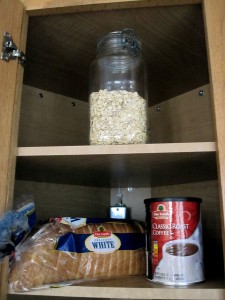An in-depth look at rural food scarcity
By: Alison Dirr
Outside Wausau, Wis., an elderly woman opens her cupboard to reveal just coffee, a can of oatmeal and a loaf of bread. She hasn’t been to the grocery store in weeks or months, or perhaps years. In recent times, this duty has fallen to her son, a truck driver, who isn’t around all that often. When he buys her groceries about every two weeks, her cupboards might be less empty, but her bank account is more so.
She worried that if she were to accept the groceries Colleen Motley offered, a family or someone recently unemployed would go hungry.

Photo by: Alison Dirr
“I get by,” she told Motley. “I’m sure there’s someone that needs it more than I do.”
Despite ongoing media coverage of “food deserts”–areas without access to healthy, fresh food–like many other elderly people in rural areas, her hunger and the vacant kitchen shelves remain hidden from view. Their struggles are invisible for personal, societal and structural reasons.
Motley is the program director for Faith in Action of Marathon County, Wis., one of more than 20 community organizations statewide that are associated with the Wisconsin InterFaith in Action Network. Motley, one other part-time employee and about 540 Marathon County volunteers assist primarily low-income seniors to help them stay in their homes. Faith in Action does this in part by coordinating with other organizations to help fill their clients’ cupboards.
“Unfortunately, she was not the exception,” Motley says of her client. “There’s a lot more people like that than you know. And you don’t see them, that’s the big thing. There’s no face on the elderly population in that aspect. This lady doesn’t get out of her house. Once in a while she goes to the doctor, and that’s the interaction she has with other people.”
Seniors in general tend to be at higher risk for isolation, says Amber Canto, poverty and food security specialist with Cooperative Extension. But many also prefer to stay silent out of embarrassment that they cannot afford food or concern about burdening their families, Motley adds.
Still, the common issue of hunger is the result of a variety of factors. Seniors in rural counties like Marathon lack access to food because they can no longer drive or carry groceries or because they must juggle the costs of prescriptions and rent with other necessities like food. And nourishment is often the most flexible expense, according to Canto.
Hunger is not the only challenge this silent population faces. Those over 60 years old with limited access to food are more likely to suffer from poor health, including higher rates of diabetes, according to a study for AARP.
